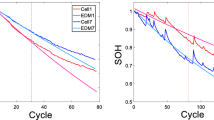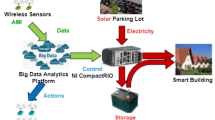Abstract
The paper presents a modeling method about the energy consumption of aluminum electrolysis process based on a new neural network. The proposed neural network (NN) is built by combining two theories of unscented Kalman filtering (UKF) and strong tracking filtering (STF), which is shortened as STUKFNN in this study. Moreover, the new training algorithm and robustness analysis of the STUKFNN are presented. The final section of the paper shows an illustrative example regarding the application of the new training algorithm to estimate the technical energy consumption of the aluminum electrolysis process, compared with the modeling methods of back-propagation neural network (BPNN), extended Kalman filtering neural network (EKFNN) and unscented Kalman filtering neural network (UKFNN). The analysis and results show that the method improves the real-time tracking ability of dynamic interference in aluminum electrolysis process, and the accuracy of STUKFNN is better than the other three modeling methods. The average indicators MAE, MSE, R of the STUKFNN based on 30 runs are 15.4793, 1862.65 and 0.9966, respectively, which are all superior to other methods. The proposed method also shows better performance compared with UKFNN, EKFNN and BPNN by the proportion of relative error (RE) in the interval \(|{\mathrm{RE}}|<0.1\%\) based on all samples, 76, 38, 22 and 74%, respectively.













Similar content being viewed by others
Abbreviations
- h :
-
The output layer function
- \(v_k\) :
-
The residual series
- n :
-
The dimension of state vector
- g(x):
-
The logistic sigmoid function
- \(\chi\) :
-
The sigma points
- \(W_{ij}\) :
-
The weight values
- \(S_k\) :
-
Sub-optimal fading factor
- \(\varepsilon\) :
-
Softening factor
- \(\rho\) :
-
Fading factor
- \(\delta\) :
-
The Kronecker \(\delta\)-function
- \(\gamma\) :
-
Hidden layers’ outputs
- \(K_k\) :
-
The filter gain
- MAE:
-
Mean absolute error
- MSE:
-
Mean square error
- R :
-
Correlation coefficient
- \(\hat{y}\) :
-
The predictive output
- \(\tau\) :
-
The current efficiency
- \(\lambda\) :
-
The spread of the sampling points
- \(\hat{{\varvec{x}}}\) :
-
State vector
- \({\varvec{P}}\) :
-
State covariance
- \({\varvec{Q}}\) :
-
The covariance of the process noise
- \({\varvec{R}}\) :
-
The covariance of the measurement noise
- EKF:
-
Extended Kalman filtering
- UKF:
-
Unscented Kalman filtering
- STF:
-
Strong tracking filtering
- FNN:
-
Feed-forward neural network
- BPNN:
-
Back-propagation neural network
- EKFNN:
-
Extended Kalman filtering neural network
- UKFNN:
-
Unscented Kalman filtering neural network
- RE:
-
Relative error
References
Yi J, Huang D, Fu S, He H, Li T (2016) Multi-objective bacterial foraging optimization algorithm based on parallel cell entropy for aluminum electrolysis production process. IEEE Trans Ind Electron 63(4):2488–2500
Yi J, Huang D, Fu S, He H, Li T (2016) Optimized relative transformation matrix using bacterial foraging algorithm for process fault detection. IEEE Trans Ind Electron 63(4):2595–2605
Yi J, Huang D, He H, Zhou W, Han Q, Li T (2017) A novel framework for fault diagnosis using kernel partial least squares based on optimal preference matrix. IEEE Trans Ind Electron 64(5):4315–4324
Geem ZW, Kim JH, Loganathan GV (2001) A new heuristic optimization algorithm: harmony search. Simulation 76(2):60–68
Yang XS (2012) Flower pollination algorithm for global optimization. In: Durand-Lose J, Jonoska N (eds) Unconventional computation and natural computation. Lecture notes in computer science, vol 7445. Springer, Berlin, Heidelberg
Abdelaziz AY, Ali ES, Elazim SMA (2016) Optimal sizing and locations of capacitors in radial distribution systems via flower pollination optimization algorithm and power loss index. Eng Sci Technol Int J 19(1):610–618
Pant S, Kumar A, Ram M (2017) Flower pollination algorithm development: a state of art review. Int J Syst Assur Eng Manag 8(2):1–9
Ali ES, Elazim SMA, Abdelaziz AY (2016) Improved harmony algorithm and power loss index for optimal locations and sizing of capacitors in radial distribution systems. Int J Electr Power Energy Syst 80:252–263
Ali ES, Elazim SMA, Abdelaziz AY (2016) Improved harmony algorithm for optimal locations and sizing of capacitors in radial distribution systems. Int J Electr Power Energy Syst 79:275–284
Hore S, Hore S, Hore S, Dey N, Ashour AS, Balas VE (2017) Particle swarm optimization trained neural network for structural failure prediction of multistoried RC buildings. Neural Comput Appl 28(8):2005–2016
Islam MS, Mohandes M, Rehman S (2017) Vertical extrapolation of wind speed using artificial neural network hybrid system. Neural Comput Appl 28(8):2351–2361
Meghlaoui A, Bui RT, Thibault J, Santerre R (1998) Predictive control of aluminum electrolytic cells using neural networks. Metall Mater Trans B Process Metall Mater Process Sci 29(5):1007–1019
Akbarpour H, Mohajeri M, Moradi M (2013) Investigation on the synthesis conditions at the interpore distance of nanoporous anodic aluminum oxide: a comparison of experimental study, artificial neural network, and multiple linear regression. Comput Mater Sci 79:75–81
Li H, Mei C, Zhou N, Tang Q, Huang Y (2006) Diagnosis of working conditions of an aluminum reduction cell based on wavelet packets and fuzzy neural network. Chem Eng Process 45(12):1074–1080
Ghosh I, Das SK, Chakraborty N (2014) An artificial neural network model to characterize porosity defects during solidification of a356 aluminum alloy. Neural Comput Appl 25(3–4):653–662
Bhattacharyay D, Kocaefe D, Kocaefe Y, Morais B (2017) An artificial neural network model for predicting the co\(_2\) reactivity of carbon anodes used in the primary aluminum production. Neural Comput Appl 28(3):553–563
Li W, Kong D, Wu J (2017) A novel hybrid model based on extreme learning machine, \(k\)-nearest neighbor regression and wavelet denoising applied to short-term electric load forecasting. Energies 10(5):694
Abbaszadeh P (2016) Improving hydrological process modeling using optimized threshold-based wavelet de-noising technique. Water Resour Manag 30(5):1701–1721
Wu X, Song Z (2013) Multi-step prediction of chaotic time-series with intermittent failures based on the generalized nonlinear filtering methods. Appl Math Comput 219(16):8584–8594
Singhal S, Wu L (1989) Training multilayer perceptrons with the extended Kalman algorithm. Adv Neural Inf Process Syst 54(4):133–140
Mekonnen G, Kumar S, Pathak PM (2016) Wireless hybrid visual servoing of omnidirectional wheeled mobile robots. Robot Auton Syst 75:450–462
Guillermo JE, Castellanos LJR, Sanchez EN, Alanis AY (2015) Detection of heart murmurs based on radial wavelet neural network with Kalman learning. Neurocomputing 164(C):307–317
Yang H, Li J, Ding F (2007) A neural network learning algorithm of chemical process modeling based on the extended Kalman filter. Neurocomputing 70(4):625–632
Choi KS, Lee SG (2010) Enhanced slam for a mobile robot using extended kalman filter and neural networks. Int J Precis Eng Manuf 11(2):255–264
Purushothaman S (2010) Tool wear monitoring using artificial neural network based on extended Kalman filter weight updation with transformed input patterns. J Intell Manuf 21(6):717–730
Tian X, Cao YP, Chen S (2011) Process fault prognosis using a fuzzy-adaptive unscented Kalman predictor. Int J Adapt Control Signal Process 25(25):813–830
Julier SJ, Uhlmann JK (2004) Unscented filtering and nonlinear estimation. Proc IEEE 92(3):401–422
Zhan R, Wan J (2006) Neural network-aided adaptive unscented Kalman filter for nonlinear state estimation. IEEE Signal Process Lett 13(7):445–448
Xue-Dong W, Yao-Nan W, Wei-Ting L, Zhi-Yu Z (2011) Generalized unscented Kalman filtering based radial basis function neural network for the prediction of ground radioactivity time series with missing data. Chin Phys B 20(6):546–551
Wu X, Wang Y (2012) Extended and unscented Kalman filtering based feedforward neural networks for time series prediction. Appl Math Model 36(3):1123–1131
Yi J, Li T, Hou J, Yao L, Tian Y (2013) Dynamic prediction model based on FNN–UKF neural networks for alumina concentration. J Sichuan Univ Eng Sci Ed 45(1):172–177
Zhang Z, Zhang J (2010) Sampling strong tracking nonlinear unscented Kalman filter and its application in eye tracking. Chin Phys B 19(10):324–332
Yao L, Zhang H, Li T, Yi J, Su Y (2016) An improved UKFNN based on square root filter for modeling of aluminum reduction. In: Proceedings of the 35th Chinese control conference, pp 3669–3672
Zhou DH, Frank PM (1996) Strong tracking Kalman filtering of nonlinear time-varying stochastic systems with coloured noise: application to parameter estimation and empirical robustness analysis. Int J Control 65(2):295–307
Li XJ, Zhou DH (2015) A method of chaotic secure communication based on strong tracking filter. Acta Phys Sin 64(14):140501–140507
Liang T, Wang M, Zhou Z (2017) State estimation for sampled-data descriptor nonlinear system: a strong tracking unscented Kalman filter approach. Math Probl Eng 2017(6):1–9
Li T, Yao L, Yi J, Hu W, Su Y, Jia W (2014) An improved UKFNN based on square root filter and strong tracking filter for dynamic evolutionary modeling of aluminum reduction cell. Acta Autom Sin 40(3):522–530
Kingston GB, Maier HR, Lambert MF (2006) A probabilistic method for assisting knowledge extraction from artificial neural networks used for hydrological prediction. Math Comput Model 44(5C6):499–512
Reyes J, Vellasco MMBR, Tanscheit R (2014) Fault detection and measurements correction for multiple sensors using a modified autoassociative neural network. Neural Comput Appl 24:1929–1941
Ruiz LGB, Rueda R, Cullar MP, Pegalajar MC (2017) Energy consumption forecasting based on Elman neural networks with evolutive optimization. Expert Syst Appl 92(2):380–389
Ma S, Wu P, Ji J, Li X (2015) Sensorless control of salient pmsm with adaptive integrator and resistance online identification using strong tracking filter. Int J Electron 103(2):1–15
Yao Y, Cheng K, Zhou ZJ, Zhang BC, Dong C, Zheng S (2015) A novel method for estimating the track-soil parameters based on Kalman and improved strong tracking filters. ISA Trans 59:450–456
Acknowledgements
This study was supported by the National Natural Science Foundation of China (Nos. 51374268, 51375520), Research Foundation of Chongqing University of Science & Technology (CK2015 Z26), Scientific and Technological Research Program of Chongqing Municipal Education Commission (KJ1401301), the Achievement Transfer Program of Institutions of Higher Education in Chongqing under Grant (KJZH14218) and Chongqing Research Program of Basic Research and Frontier Technology under Grants (cstc2017jcyjAX0063, cstc2015jcyjBX0099).
Author information
Authors and Affiliations
Corresponding author
Ethics declarations
Conflict of interest
The authors declare that they have no conflict of interest.
Rights and permissions
About this article
Cite this article
Yao, L., Li, T., Li, Y. et al. An improved feed-forward neural network based on UKF and strong tracking filtering to establish energy consumption model for aluminum electrolysis process. Neural Comput & Applic 31, 4271–4285 (2019). https://doi.org/10.1007/s00521-018-3357-9
Received:
Accepted:
Published:
Issue Date:
DOI: https://doi.org/10.1007/s00521-018-3357-9




